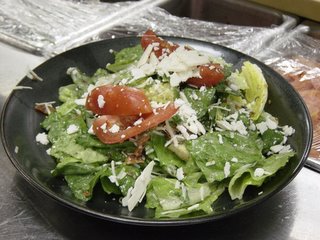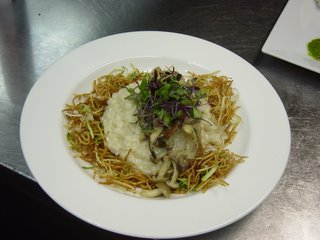Week Six
Wow, two posts in one day. And yes, I'm now caught up with my modules. This one's another summary. I admit that this sounds pretty sappy, but I'm not embellishing here; Canlis is an amazing place to work for all the reasons I've listed. I'd be thrilled to get a job here in any capacity after graduation.
--
Things have continued to go well at Canlis Restaurant, and I am amazed almost on a daily basis how great a place it is to work. In many respects, the atmosphere is exactly the opposite of the typical restaurant industry stereotype—ownership and management at Canlis truly care about more than money, and are genuine in their affinity for employees and guests alike. That isn’t just talk, either. Canlis employees have access to health benefits, a 401(k) plan with company matching, and even a profit sharing system which in 2005 gave a full ten percent of the restaurant’s profits back to its employees.
If those three plans weren’t enough, Canlis offers little perks as well. Two of the line cooks told me that for Christmas, each person in the kitchen received a crêpe pan as a gift, including one cook who had only been working at the restaurant for two weeks. At a recent meeting, managing owner Mark Canlis and his wife invited the entire staff on a snowshoeing trip in early March, on a Sunday when the restaurant is closed. Upon returning from the trip in the afternoon, everyone is invited for pizza at the Canlis’ home just up the hill from the restaurant.
For an owner who isn’t a chef-owner, Mark Canlis is incredibly hands-on. He regularly dons a suit and works the floor, greeting guests and connecting with regulars. Last week while chatting with the line cooks near the end of a shift, he took a minute to wrap a few hotel pans with plastic that were on their way to the walk-in at the end of the night, then apologized to Sous Chef Norm that his wrapping skills needed some work. Another time, while dining at the restaurant, he brought back a Brussels Sprouts and Cauliflower Cassolette, one of the newest menu items, to say it wasn’t quite up to standards. He wasn’t upset about it—he instead offered a few ideas and suggested we do some experimentation with the dish.
This is not to say that Canlis isn’t run to make money, because it most certainly is. The difference is that employees are made to feel that it’s their company too, that the restaurant doing well means good things for them, rather than being made to feel as though they’re working hard for someone else without reaping the rewards themselves. The profit sharing system is designed to foster this feeling—Mark Canlis says that through the system, each employee owns shares of the restaurant, but without the actual risk of owning shares of a business.
Another amazing aspect of Canlis is that despite their incredible success over the past fifty-five years, the Canlis family and the restaurant’s management team aren’t content to rest on their laurels. At a recent all-staff meeting, the newly-formed, eight-person executive team detailed the restaurant’s vision for the future and made it very clear that every single person there should try to make the restaurant a better place to work and dine every day they come to work. It’s certainly true that on some level every job is just that—just a job—the positive, supportive, and forward-looking atmosphere put forth from the top down makes working at Canlis feel more like being part of something tangible rather than just going to work to pay the bills.
From a practical standpoint, the kitchen has been making progress as well. Personally, I’ve been challenged by Chef Aaron on a variety of culinary topics. In particular, he has pushed me to learn that butter sauces aren’t nearly as delicate as the conventional wisdom would have you believe and can be made much faster than is often taught. As a result, I’ve been able to cut down on the time it takes me to complete my sauces each day, allowing for more time to work on other aspects of prep.
For the kitchen as a whole, Chefs Aaron and Jeff recently decided that the dynamics of the hotline were, for some reason, not quite right. Specifically, the communication between my station and the plating station was off, leading to struggles during busy points of a shift. To investigate the problem, Chef Aaron worked the plating station one night and Taylor, who generally works the plating station, worked my station. Chef Aaron fished out several inefficiencies caused by last month’s menu change, and as a result, the hotline decided after Saturday night’s shift to change the way calls are made. Rather than call for the specific items he needs from the sauté and vegetable stations, Taylor now calls for the plate as a whole (i.e., “Lobster” instead of “Market Greens and Gratin”). As a result, he’s able to communicate the same information using fewer words and clearer language. This might sound like a little thing, but the last chef I worked for wouldn’t have taken the time to work the line and figure out the problem. Instead, he would have told the cooks involved, “This isn’t working. Fix it.”
In short, nobody is on their own at Canlis. People are more than willing to help you out, because they want you to improve. And when you improve, the restaurant as a whole can improve... and that, ultimately, is the goal of everything Canlis does.
--
Things have continued to go well at Canlis Restaurant, and I am amazed almost on a daily basis how great a place it is to work. In many respects, the atmosphere is exactly the opposite of the typical restaurant industry stereotype—ownership and management at Canlis truly care about more than money, and are genuine in their affinity for employees and guests alike. That isn’t just talk, either. Canlis employees have access to health benefits, a 401(k) plan with company matching, and even a profit sharing system which in 2005 gave a full ten percent of the restaurant’s profits back to its employees.
If those three plans weren’t enough, Canlis offers little perks as well. Two of the line cooks told me that for Christmas, each person in the kitchen received a crêpe pan as a gift, including one cook who had only been working at the restaurant for two weeks. At a recent meeting, managing owner Mark Canlis and his wife invited the entire staff on a snowshoeing trip in early March, on a Sunday when the restaurant is closed. Upon returning from the trip in the afternoon, everyone is invited for pizza at the Canlis’ home just up the hill from the restaurant.
For an owner who isn’t a chef-owner, Mark Canlis is incredibly hands-on. He regularly dons a suit and works the floor, greeting guests and connecting with regulars. Last week while chatting with the line cooks near the end of a shift, he took a minute to wrap a few hotel pans with plastic that were on their way to the walk-in at the end of the night, then apologized to Sous Chef Norm that his wrapping skills needed some work. Another time, while dining at the restaurant, he brought back a Brussels Sprouts and Cauliflower Cassolette, one of the newest menu items, to say it wasn’t quite up to standards. He wasn’t upset about it—he instead offered a few ideas and suggested we do some experimentation with the dish.
This is not to say that Canlis isn’t run to make money, because it most certainly is. The difference is that employees are made to feel that it’s their company too, that the restaurant doing well means good things for them, rather than being made to feel as though they’re working hard for someone else without reaping the rewards themselves. The profit sharing system is designed to foster this feeling—Mark Canlis says that through the system, each employee owns shares of the restaurant, but without the actual risk of owning shares of a business.
Another amazing aspect of Canlis is that despite their incredible success over the past fifty-five years, the Canlis family and the restaurant’s management team aren’t content to rest on their laurels. At a recent all-staff meeting, the newly-formed, eight-person executive team detailed the restaurant’s vision for the future and made it very clear that every single person there should try to make the restaurant a better place to work and dine every day they come to work. It’s certainly true that on some level every job is just that—just a job—the positive, supportive, and forward-looking atmosphere put forth from the top down makes working at Canlis feel more like being part of something tangible rather than just going to work to pay the bills.
From a practical standpoint, the kitchen has been making progress as well. Personally, I’ve been challenged by Chef Aaron on a variety of culinary topics. In particular, he has pushed me to learn that butter sauces aren’t nearly as delicate as the conventional wisdom would have you believe and can be made much faster than is often taught. As a result, I’ve been able to cut down on the time it takes me to complete my sauces each day, allowing for more time to work on other aspects of prep.
For the kitchen as a whole, Chefs Aaron and Jeff recently decided that the dynamics of the hotline were, for some reason, not quite right. Specifically, the communication between my station and the plating station was off, leading to struggles during busy points of a shift. To investigate the problem, Chef Aaron worked the plating station one night and Taylor, who generally works the plating station, worked my station. Chef Aaron fished out several inefficiencies caused by last month’s menu change, and as a result, the hotline decided after Saturday night’s shift to change the way calls are made. Rather than call for the specific items he needs from the sauté and vegetable stations, Taylor now calls for the plate as a whole (i.e., “Lobster” instead of “Market Greens and Gratin”). As a result, he’s able to communicate the same information using fewer words and clearer language. This might sound like a little thing, but the last chef I worked for wouldn’t have taken the time to work the line and figure out the problem. Instead, he would have told the cooks involved, “This isn’t working. Fix it.”
In short, nobody is on their own at Canlis. People are more than willing to help you out, because they want you to improve. And when you improve, the restaurant as a whole can improve... and that, ultimately, is the goal of everything Canlis does.







